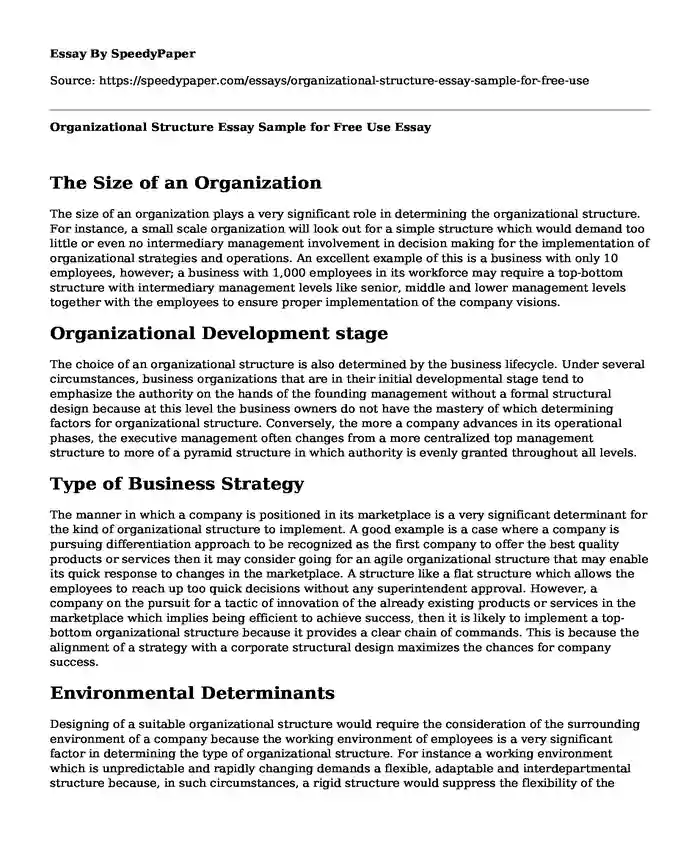
| Type of paper: | Critical thinking |
| Categories: | Management Business strategy |
| Pages: | 4 |
| Wordcount: | 845 words |
The Size of an Organization
The size of an organization plays a very significant role in determining the organizational structure. For instance, a small scale organization will look out for a simple structure which would demand too little or even no intermediary management involvement in decision making for the implementation of organizational strategies and operations. An excellent example of this is a business with only 10 employees, however; a business with 1,000 employees in its workforce may require a top-bottom structure with intermediary management levels like senior, middle and lower management levels together with the employees to ensure proper implementation of the company visions.
Organizational Development stage
The choice of an organizational structure is also determined by the business lifecycle. Under several circumstances, business organizations that are in their initial developmental stage tend to emphasize the authority on the hands of the founding management without a formal structural design because at this level the business owners do not have the mastery of which determining factors for organizational structure. Conversely, the more a company advances in its operational phases, the executive management often changes from a more centralized top management structure to more of a pyramid structure in which authority is evenly granted throughout all levels.
Type of Business Strategy
The manner in which a company is positioned in its marketplace is a very significant determinant for the kind of organizational structure to implement. A good example is a case where a company is pursuing differentiation approach to be recognized as the first company to offer the best quality products or services then it may consider going for an agile organizational structure that may enable its quick response to changes in the marketplace. A structure like a flat structure which allows the employees to reach up too quick decisions without any superintendent approval. However, a company on the pursuit for a tactic of innovation of the already existing products or services in the marketplace which implies being efficient to achieve success, then it is likely to implement a top-bottom organizational structure because it provides a clear chain of commands. This is because the alignment of a strategy with a corporate structural design maximizes the chances for company success.
Environmental Determinants
Designing of a suitable organizational structure would require the consideration of the surrounding environment of a company because the working environment of employees is a very significant factor in determining the type of organizational structure. For instance a working environment which is unpredictable and rapidly changing demands a flexible, adaptable and interdepartmental structure because, in such circumstances, a rigid structure would suppress the flexibility of the employees. Therefore, structural designers can build flat management with decentralized decision making. However, a stable and predictable environment would enable the implementation of a structure with well-defined duties and integrated authority.
Organizational Structural Design
The various structural designs have their merits and demerits, and that should be considered when determining which to implement. For example, functional and divisional structures are the two common structures. The functional structure establishes departments within an organization depending on business activities like production, sales and marketing, and finance. Even though the establishment of these departments can increase efficiency, it can also create barriers between departments. The divisional structure implies the organization of company operations depending on the product, customers or geography in regards to the marketing, production and finance capabilities. Even though this may appear to make company divisions focused and responsive, it creates redundancy of business activities amongst the divisions and even within the whole organization.
Customer Interaction
Customer interaction dictates the type of organizational structure because it demands a wide-range focus of power and the participation of the whole organization. Therefore, a company should seek for the implementation of an organizational structure that enables the enactment of good customer interaction.
References
Armstrong, M. and Taylor, S., 2014. Armstrong's handbook of human resource management practice. Kogan Page Publishers.
Bell, E., Bryman, A. and Harley, B., 2018. Business research methods. Oxford university press.
Ganter, A. and Hecker, A., 2014. Configurational paths to organizational innovation: qualitative comparative analyses of antecedents and contingencies. Journal of Business Research, 67(6), pp.1285-1292.
Harper, C., 2015. Organizations: Structures, processes and outcomes. Routledge.
Kerzner, H. and Kerzner, H.R., 2017. Project management: a systems approach to planning, scheduling, and controlling. John Wiley & Sons.
Melchers, R.E. and Beck, A.T., 2018. Structural reliability analysis and prediction. John Wiley & Sons.
Rosemann, M. and vom Brooke, J., 2015. The six core elements of business process management. In Handbook on business process management 1 (pp. 105-122). Springer, Berlin, Heidelberg.
San Cristobal, J.R., Fernandez, V. and Diaz, E., 2018. An analysis of the main project organizational structures: Advantages, disadvantages, and factors affecting their selection. Procedia computer science, 138, pp.791-798.
Scott, W.R., 2015. Organizations and organizing: Rational, natural and open systems perspectives. Routledge.
Sekaran, U. and Bougie, R., 2016. Research methods for business: A skill building approach. John Wiley & Sons.
Todorovic, M.L., Petrovic, D.C., Mihic, M.M., Obradovic, V.L. and Bushuyev, S.D., 2015. Project success analysis framework: A knowledge-based approach in project management. International Journal of Project Management, 33(4), pp.772-783.
Cite this page
Organizational Structure Essay Sample for Free Use. (2022, Oct 12). Retrieved from https://speedypaper.net/essays/organizational-structure-essay-sample-for-free-use
Request Removal
If you are the original author of this essay and no longer wish to have it published on the SpeedyPaper website, please click below to request its removal:
- Free Essay Sample on Peak Oil Theory
- Ancient History Essay Example: Background of Egyptian Civilization
- Free Essay Sample about Hospital-acquired Pressure
- An Analysis of Corruption in Sports, Essay Example for Students
- Free Essay Comprising a Business Management Article Review
- Essay Sample on Prime Factors Concerning the Determination of a Firm's CEO's Remuneration
- Essay Sample on Repositioning and Pressure Redistribution Mattress in Preventing Pressure Ulcers
Popular categories




